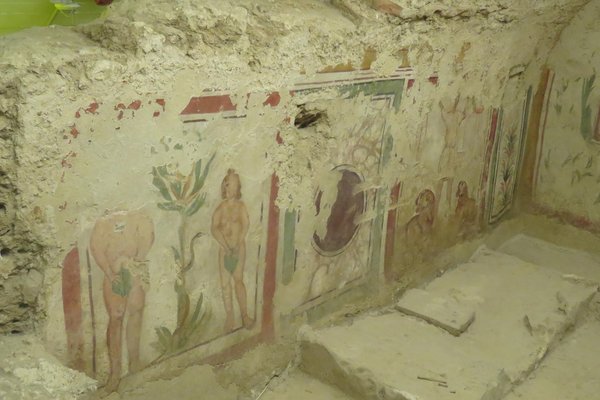Hungary
Early Christian Necropolis of Pécs
The Early Christian Necropolis of Pécs (Sopianae) shows distinctive architecture and impressive murals depicting Christian themes.
These funerary monuments date from the Late Roman Empire when Pécs (then named Sopianae) was an important city in the Roman province of Pannonia. Among them are burial chambers, chapels and a mausoleum. Typical for the site is the two-storey building, with an above-ground chapel and a subterranean burial chamber. Some of these include murals.
Community Perspective: Pecs is a worthwhile destination in itself, and one can easily spend an hour or two checking out these Early Christian monuments. The main site, Cella Septichora, has a visitor center (which, like the underground mausoleum, is closed on Mondays).
Site Info
Official Information
- Full Name
- Early Christian Necropolis of Pécs (Sopianae) (ID: 853)
- Country
- Hungary
- Status
-
Inscribed 2000
Site history
History of Early Christian Necropolis of Pécs
- 2003: Name change
- From "Pécs (Sopianae) Early Christian Cemetery" to "Early Christian Necropolis of Pécs (Sopianae)"
- 2000: Revision
- Was reduced from former TWHS Cultural Stratification in the Historic Centre of Pecs (1998)
- 2000: Inscribed
- Inscribed
- 1998: Requested by State Party to not be examined
- Bureau - ICOMOS No (later withdrawn by Hun)
- Type
- Cultural
- Criteria
- iii
- iv
Links
- UNESCO
- whc.unesco.org
- Official
-
- pecsorokseg.hu — World Heritage Pecs
All Links
UNESCO.org
- whc.unesco.org — whc.unesco.org/
Official Website
- pecsorokseg.hu — World Heritage Pecs
News Article
- June 4, 2010 caboodle.hu — Pécs World Heritage site damaged by rain
Community Information
- Community Category
- Secular structure: Burial
Travel Information
Budapest hotspot
Recent Connections
-
Depicted in Mizielinska Maps
Necropolis, Pecs CathedralSee i.pinim…
-
Unfinished constructions
The Cella Septichora (no roof tiles hav… -
Reduced from broader TWHS
TWHS originally included later monument…
Connections of Early Christian Necropolis of Pécs
- Trivia
-
-
Subterranean Cultural Sites
-
Depicted in Mizielinska Maps
Necropolis, Pecs CathedralSee i.pinimg.com
-
- World Heritage Process
-
-
Reduced from broader TWHS
TWHS originally included later monuments, mainly art nouveau.
-
- Constructions
-
-
Necropolises
-
Mausolea
The Early Christian Mausoleum -
Unfinished constructions
The Cella Septichora (no roof tiles have been found)
-
- WHS on Other Lists
-
-
European Capital of Culture
Pecs 2010
-
- Timeline
-
-
Built in the 4th century
Tombs date from the 4th century
-
- WHS Hotspots
-
-
Budapest hotspot
Pecs is 2.5h away by bihourly direct train
-
- WHS Names
-
-
Name changes
cemetery changed to necropolis (2003)
-
News
- caboodle.hu 06/04/2010
- Pécs World Heritage site damaged b…
Recent Visitors
Visitors of Early Christian Necropolis of Pécs
- Adrian Turtschi
- Alexander Barabanov
- Alexander Lehmann
- Ali Zingstra
- Aljaz
- Anna Wludarska
- Argo
- Atila Ege
- Attiska
- Badwater
- BaziFettehenne
- Bill Maurmann
- Bin
- Brendan Carroll
- Can SARICA
- Carlos Sotelo
- Christer Sundberg
- Christian Wagner
- Clyde
- Csaba Nováczky
- CugelVance
- Dagmara
- daneva
- David Berlanda
- David Marton
- Dimitar Krastev
- Dr. Caligari
- Els Slots
- Eva Kisgyorgy
- Evgenii
- Fan Yibo
- Farinelli
- Filip Murlak
- FK
- George Gdanski
- GeorgeIng61
- Gernot
- HaraldOest
- Harald T.
- Harry Mitsidis
- henrik_hannfors
- hszaby
- Hubert
- Hurrvinek
- Iain Jackson
- Ivan Rucek
- Jacob Choi
- Jarek Pokrzywnicki
- Jasam
- Jeanne OGrady
- Jonas Kremer
- jonathanfr
- Joyce van Soest
- Judit Andrea Juhász
- KarenBMoore
- Kerékgyártó
- Klaus Freisinger
- Krijn
- Kurt Lauer
- kutasp
- Lara Adler
- Lisu Marian
- Loic Pedras
- Luboang
- Lucas Del Puppo
- Lucio
- Luis Filipe Gaspar
- Maciej Gil
- Małgosia Łupicka
- marc Rouserez
- Martin
- Martina Rúčková
- Marton Kemeny
- MatusBeber
- Michaela0705
- Michael Turtle
- Mikko
- Milan Jirasek
- nan
- Nihal Ege
- Patrik
- Paul Schofield
- Peter Lööv
- Philipp Leu
- Philipp Peterer
- Pincze
- Purrfect
- Qin Xie
- Rafał Kałczuga
- Randi Thomsen
- Reza
- Rob Wilson
- Roger Ourset
- Roman Bruehwiler
- Roman Raab
- Sebasfhb
- Sergio Arjona
- Slavi
- Solivagant
- Stanislaw Warwas
- Svein Elias
- Szabolcs Mosonyi
- Szabo Viktoria
- Szucs Tamas
- Tamara Ratz
- Taotao Chen
- Tarquinio_Superbo
- Tevity
- Thomas Buechler
- Thomas van der Walt
- triath
- Tsunami
- Twobaconsandaboston
- Vanessa Buechler
- Van Hung
- WalGra
- Westwards
- Wojciech Fedoruk
- YaroMir
- Yevhen Ivanovych
- Zoë Sheng
- Zsuzsanna Forray
Community Reviews
Show full reviews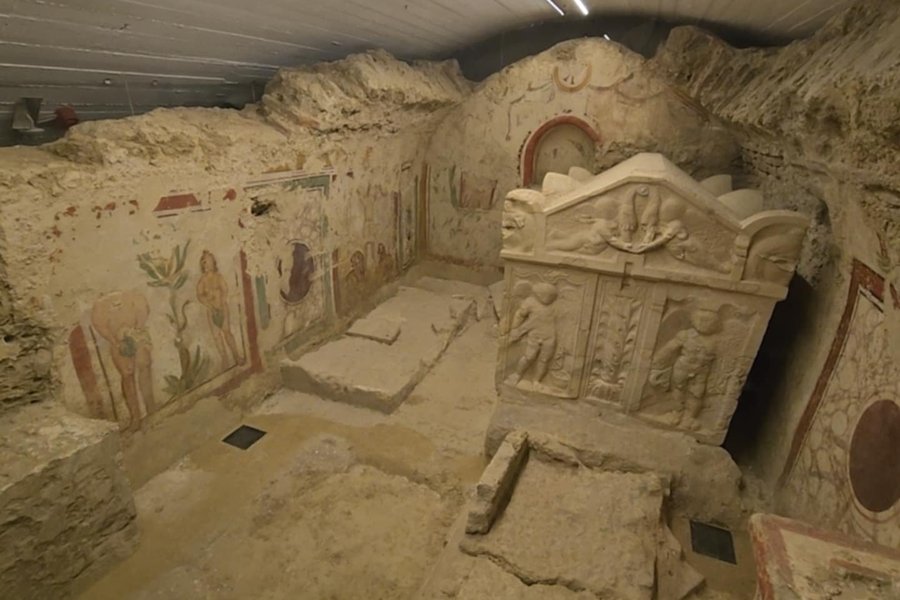
This little gem of a place is tucked away in the southwestern corner of Hungary, a bit of a lonely island away from other UNESCO sites so a dedicated day trip to visit was required. We visited on Thursday 23 July 2025, after hiring a car from Subotica (Serbia) and driving the 153klms to Pecs to explore this site for the day.
A visit to the OUV sites of the Cella Septichora Visitor Centre and the Early Christian Mausoleum (100 metres across the road) which the underground component to the public is now open, having been closed in 2022 for renovations. The cost of a ticket to visit both sites is 3600 HUF (Aus $16). Other tickets can be purchased to view other historical parts of Pecs at reduced rates as well.
Give yourself about 2 - 3 hours to explore both sites. The main visitor centre is much larger and provides access and viewings of 7 Burial Chambers. The Wine Pitcher Bural Chamber, Burial Chambers III, IV, V, XIX, XX and Peter & Paul Burial Chamber. Good signage and information is available including a variety of printed documents, multi-media visual and audio.
We enjoyed the sites, and the visitor experiences provided in each of the locations as they were very informative, so the use of a guide is not specifically needed or warranted. Although different civilisations, having recently visited the Etruscan Necropolis site in Tarquinia in March 2025, we found the painted burial chambers in Tarquinia more interesting. That …
Keep reading 0 comments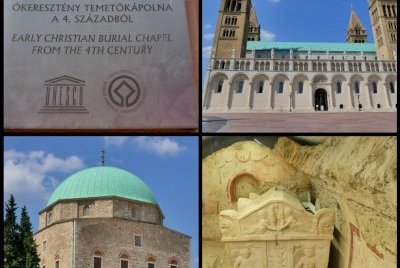
I visited this WHS in 2022 as a very convenient stopover between Budapest and Serbia, and I followed other reviewers' recommendation to stay over at the Art Nouveau Palatinus Grand Hotel at the heart of Pecs with great underground parking. The area of Pecs has been inhabited continuously for about 2,000 years, ever since the Roman times (when Pecs was known as Sopianae). However, the focus of this WHS are the early Christian necropolis sites, located in the northwest of the inner city on the slopes of the Mecsek Hills, in the vicinity of the cathedral. They are regarded as the largest single Christian tomb complex outside Italy.
The community of Sopianae built a significant number of burial structures (chapels, burial chambers, built tombs) in the 4th century. These buildings' OUV lies in their architecture as well as their artistic features. The first Paleo-Christian burial chamber to be unearthed way back in 1782 was the Peter and Paul octagonal burial chamber and most of the excavations took place after inscription on the WH list in the year 2000. In total 16 burial chambers and several hundred tombs were discovered. Of the 16 burial chambers, 5 are painted burial chambers. The barrel vaulted burial chamber between the Cella Trichora and the Cella Septichora was probably the burial place of a revered member of the community. Early Christian art was not primarily intended as a decoration. Paintings, sculptures and even buildings served as symbols. The painters are unknown, but probably they …
Keep reading 0 commentsAlexander Barabanov
Early Christian Necropolis of Pécs
Early Christian Necropolis of Pécs (Inscribed)
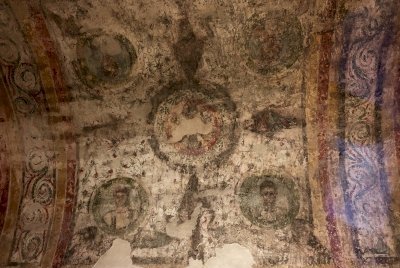
Visited this site in April 2019 as a deviation from the road to thermal waters of Heviz. Pecs is very lovely town with beatiful cathedral, ramparts, pedestrian streets and traditional restaurants. The combined ticket price is now 1,900 Forints (6 Euro). Cella Septichora has three important tombs: Peter-Paul Tomb; Jug Tomb and Octagonal Tomb. First two are still covered with annoying blicking glass covers disturbing photo taking. However, the site is very vell preserved and covered with tailor-made fittings, stairs, passages and surface windows. Mausoleum contains another beautiful burial painted chamber with marble sarcophagus. It was interesting to find out what the letters from the famous Pecs symbol of christianity mean: Greek letters X (chi) and P (rho) are the first two letters of the name of Christ and letters A (alpha) and ω (omega) are the first and last letters of the Greek alphabet, symbolizing the beginning and the end. In overall, this site deserves its inscription, even if it could not be compared with Roman sites in Italy, but given its distant location from everywhere it was quite unique to construct such decorated burial chambers in province. Combined with overall pleasent ambience of the town this is a good site to visit.
Keep reading 0 comments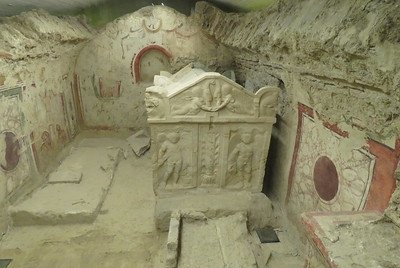
The Early Christian Necropolis of Pécs represents a mix of three categories of sites: it's a Burial site, an Archaeological site of Ancient Rome and a Christian religious structure. Its OUV is mostly derived from its wall paintings. Pécs is a midsized city in the south of Hungary, and I went there for a weekend trip reaching it via a 2-hour flight to Budapest and then a 2 hour 50-minute direct train ride. The town was very quiet, but it had a cosy Christmas fair in front of its landmark (former) Mosque of Pasha Qasim.
The core zone of this WHS lies in front of Pécs Cathedral and mostly underneath cathedral square. On my first approach, I walked across the glass ceilings from where you can look into the Roman site, but I could not find the way in! So I walked on to the mausoleum which fortunately has a clearly visible structure remaining above ground. It’s all out in the open, this is the only part that you can see without paying the entrance fee. That fee by the way is 1100 forint, about 3.5 EUR, and it covers both the mausoleum and the Cella Septichora visitor center.
The mausoleum burial chamber is just a few square meters large but has all the nice features: a sarcophagus (pieced back together again), colourful murals with recognizable biblical themes and some abstract figures such as a red disk.
Via the map on the entrance ticket, I found out …
Keep reading 0 comments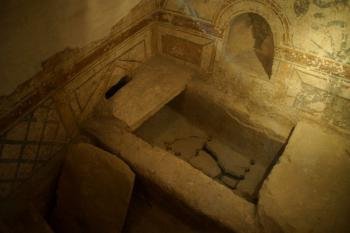
For World Heritage enthusiasts Pécs is located in the middle of nowhere, the next WHS is in a straight-line distance of 170 kilometres (Budapest), which is quite a lot on a continent that is so densely covered with World Heritage Sites. Initially the nomination included the entire historic old town, but I think it was a wise decision to reduce it to the Early Christian necropolis. Pécs is a charming town and has a lot to offer, buildings from all important periods of the city's history and interesting museums, but the necropolis is by far the most outstanding monument.
The settlement of the Roman period was in the area of today's city centre, the early Christian necropolis is located in the north-west below the cathedral square and the surrounding buildings. The WHS comprises four sites with separate entrances. Best to start at the new visitors centre, the Cella Septichora. After the ticket desk you first come to the remains of the eponymous building, it is also the largest structure of the whole complex, with a length of about 20 metres. The Cella Septichora got its name because of the seven apses. But the main attraction are the burial chambers with wall paintings dating from the 4th century. The largest tombs are two-storey buildings: a crypt and above ground a mausoleum or chapel. Models illustrate the presumed architecture of the most important tombs.
First we went to the Chamber with the Jug with well-preserved wall paintings, the jug is painted in …
Keep reading 0 comments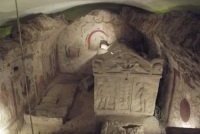
Taking the good advice I visited on a Tuesday with no hassles. The underground chamber with its frescoes and sarcophagus was spectacular despite the glass wall. The other sights in Pecs were less spectacular, although I liked the interior of the Mosque Church in Szechenyi Square.
I went there on a day trip by train from Budapest, and had plenty of time to see everything.
Keep reading 0 comments
The first advice about visiting the Pecs site is don’t go there on a Monday – you need to go “inside” really to appreciate the WHS and it is “closed” on that day. I put that in quotes since, in our case, this turned out to be “negotiable”, but I wouldn’t want to rely on a successful outcome!
The site consists of 4 small locations around the cathedral square. Only 1, the ground plan of an early Christian mausoleum due south of the cathedral, is visible from the exterior. But even this seemed to have an “entrance” to an underground portion which was shuttered we were there –the “open” part was unremarkable. 2 further sites are behind the entrances of buildings in nearby Apaca St – only 1 was marked with a UNESCO sign and the door was firmly locked so I can’t describe what might be on show. The descriptions in guide books are fairly low key. Which leaves the main location. This consists of a series of underground tombs which can only be entered through the Cella Septicora Visitor Centre situated NE of the mausoleum.
The original structures consisted of an above ground monument and a subterranean tomb. The passing centuries have seen the hillside slip on top of the remains together with further covering by a sequence of subsequent (re)building/destruction etc – the result is a 2 storey subterranean archaeological site consisting of remains from both levels. Those reached via the Visitor Centre are largely “tunnelled” well …
Keep reading 0 comments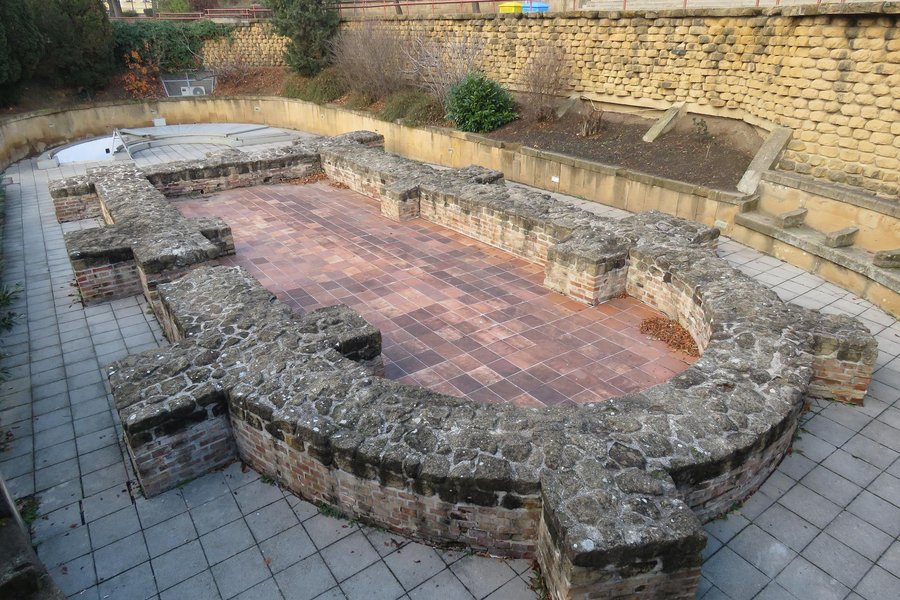
Located in Southern Hungary near the Croatian border, Pécs is Hungary's second-most visited city, and rightly so. It has a compact old town which can be easily explored on foot, with buildings from many epochs (late Roman to 20th century) and religions (churches, former mosques converted into churches, active mosques and synagogues).
The Roman sites are very central and very well signposted (they make a lot of their WH status). There is a brand new visitor centre above the main site, called Cella Septichora. The remains themselves are reasonably interesting (of course nothing compared to Rome, but nice for a provincial town), and show biblical scenes from the dawn of the Christian era in the Roman Empire.
Pécs is connected by direct trains to Budapest and Vienna. Like Christer, I stayed at the Palatinus, which is a really nice and traditional hotel.
Keep reading 0 comments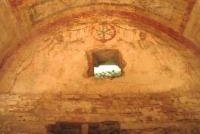
As in many places in central and southern Europe, it all started with a Roman settlement. By the foot of the Mecsek Hills they found water, fertile soil and a generally nice place to stay at. They named the town Sophianne and it became the centre of Lower Pannonia. The Romans also brought Christianity with them and the World Heritage Site of Pecs is about exactly this – early Roman, Christian tombs, in a condition not found anywhere else in the world. All the Roman tombs are centrally located around Pecs’s beautiful Basilica of St.Peter with its four towers. The tombs are small and narrow and Christian symbols decorate the graves. There are biblical frescos, Adam and Eve, Daniel in the lions den and the Jug – the Holy Sacrament.
The Roman tombs are easily visited in a one or two hours if you are in a hurry, but in my opinion Pecs is worth a better destiny. The town is actually considered to be the second most beautiful city in the country after Budapest and having stayed around for a couple of days I can surely agree. It’s a fine climate and today the Old Town is just filled with beautiful architecture making it a perfect stop for a couple of days.
After the Romans, Pecs got back on the map again in the Middle Ages as a major stop on the route to Byzantium. But then the Turks attacked and made it into an administrative centre, which is …
Keep reading 0 comments
